Elevated Need for Financial Close Transformation Across Mid-Market Organizations
Meet the Experts
Key Takeaways
⇨ Mid-market organizations recognize the need to automate their financial close processes to improve closing efficiency.
⇨ These organizations can find themselves in a difficult situation where they know they need to automate their financial close process but lack the resources to do so effectively.
⇨ Mid-market organizations can leverage process-specific automation solutions to help address core challenges within the closing process.
Mid-market organizations recognize the need to transform their financial close processes to improve financial closing efficiency. Findings from SAPinsider’s Financial Close Transformation benchmark report show that 76% of mid-market survey respondents still heavily rely on manual methods and legacy tools during the closing cycle, resulting in financial close inefficiencies. It helps explain why automation is the top factor driving mid-market organizations to evaluate their strategic priorities for financial close transformation. The focus on automation is critical in ensuring that mid-market organizations can successfully move away from manual methods and legacy tools. This is why the need for financial close transformation to improve efficiency is much higher among mid-market firms than their larger counterparts (Figure 1).

In addition, SAPinsider research found that mid-market organizations register an average closing cycle of nine days compared to seven for enterprise organizations. This despite the fact that mid-market organizations manage an average of 29 entities in mid-market closing cycles compared to an average of 48 entities involved in enterprise closing cycles).
Not surprisingly, mid-market firms are often too large for manual methods but manage budgets too small to support a large-scale ERP upgrade, such as a move to SAP S/4HANA (40% of mid-market organizations cited budget as a barrier). As a result, many mid-market firms find themselves stuck in the middle; they know they need to automate their financial close process but lack the resources to do so effectively. This provides context for SAPinsider findings that suggest mid-market organizations are more likely to prioritize transitioning from month-end closes to continuous financial closes, as they aim for faster closing cycles.
Mid-market organizations remain laser-focused on transforming their financial close process to improve closing efficiency, a shared goal with enterprise organizations. Our data suggests organizations of all sizes can benefit from process-specific automation solutions to address significant challenges within targeted areas of the closing process. We see that intercompany accounting and balance sheet substantiation are particularly difficult for mid-markets compared to enterprises, according to SAPinsider’s research (Figure 2).

It’s important to note that balance sheet data is invaluable in providing financial auditors assurance on a company’s statements while meeting key U.S. Sarbanes-Oxley regulations through certifying and approving account balances. For mid-market organizations running SAP ERP, solution extensions by BlackLine, such as SAP Account Substantiation and Automation, complement SAP ECC or SAP S/4HANA to help enable standardization and visibility across a key challenge area for SAPinsider organizations.
Automating best practices across difficult areas of closing cycles can help mid-market organizations streamline operations while reducing costs associated with inefficient manual processes that rely heavily on spreadsheets. Most mid-market organizations also aim to enable financial close transformation strategies with requirements that prioritize workflow and task automation, starting with automated and standardized closing processes and alerts (90% of mid-market respondent organizations), followed by automated reconciliations (82% of mid-market respondent organizations) and automated journal entries (77%) (Figure 3).

Mid-market firms navigating legacy systems and manual processes can prioritize financial close transformation to improve efficiency, accuracy, and compliance. Automating repetitive tasks through digital technology reduces cost while streamlining financial consolidation efforts and standardizing workflows to enhance closing cycles. Ultimately, organizations can gain improved control and visibility across finance operations by adopting automated best practices and solutions into their financial close transformation strategies.
Make sure to download and read our Financial Close Transformation Benchmark Report available for all members of the SAPinsider Community.








